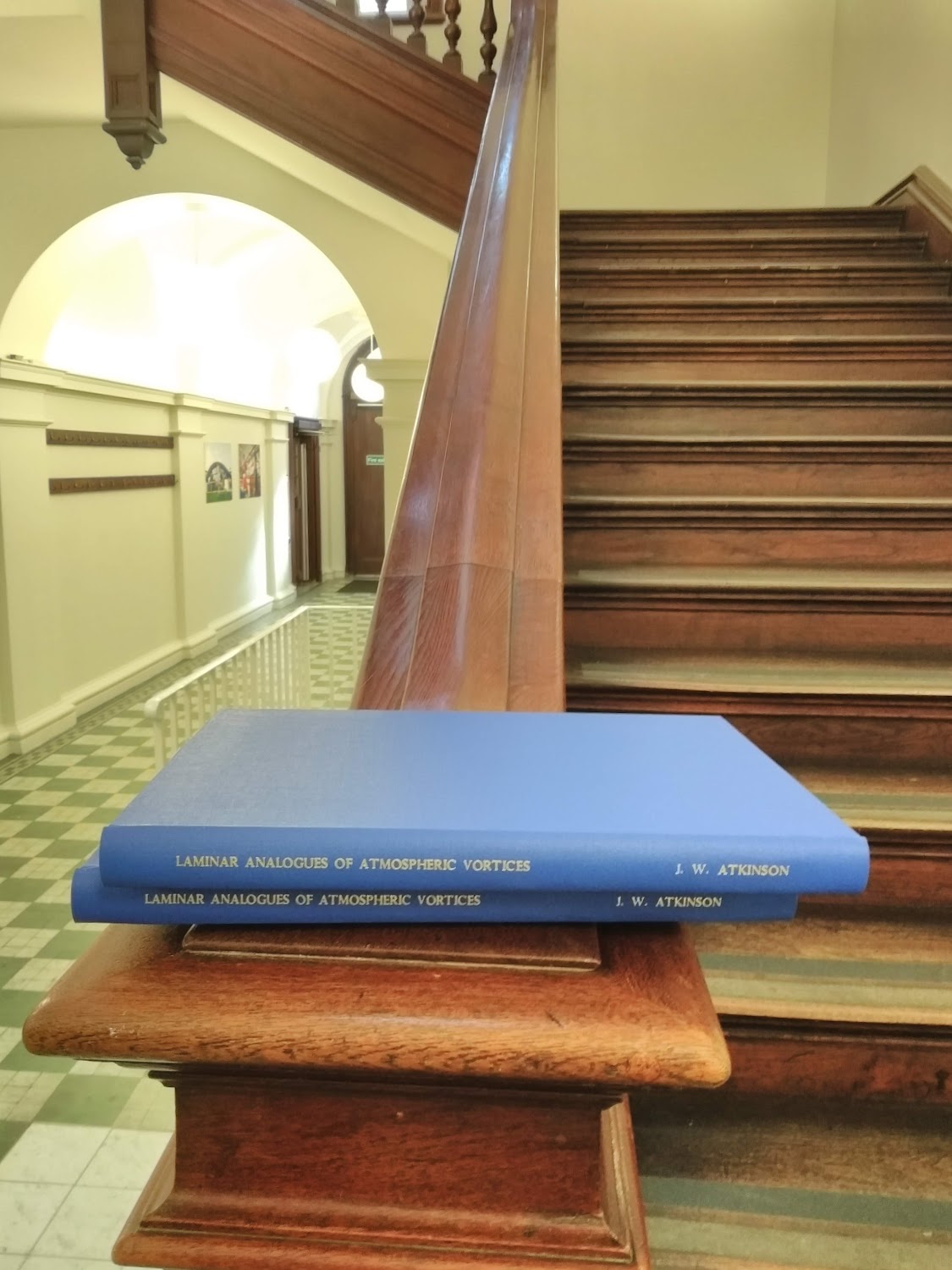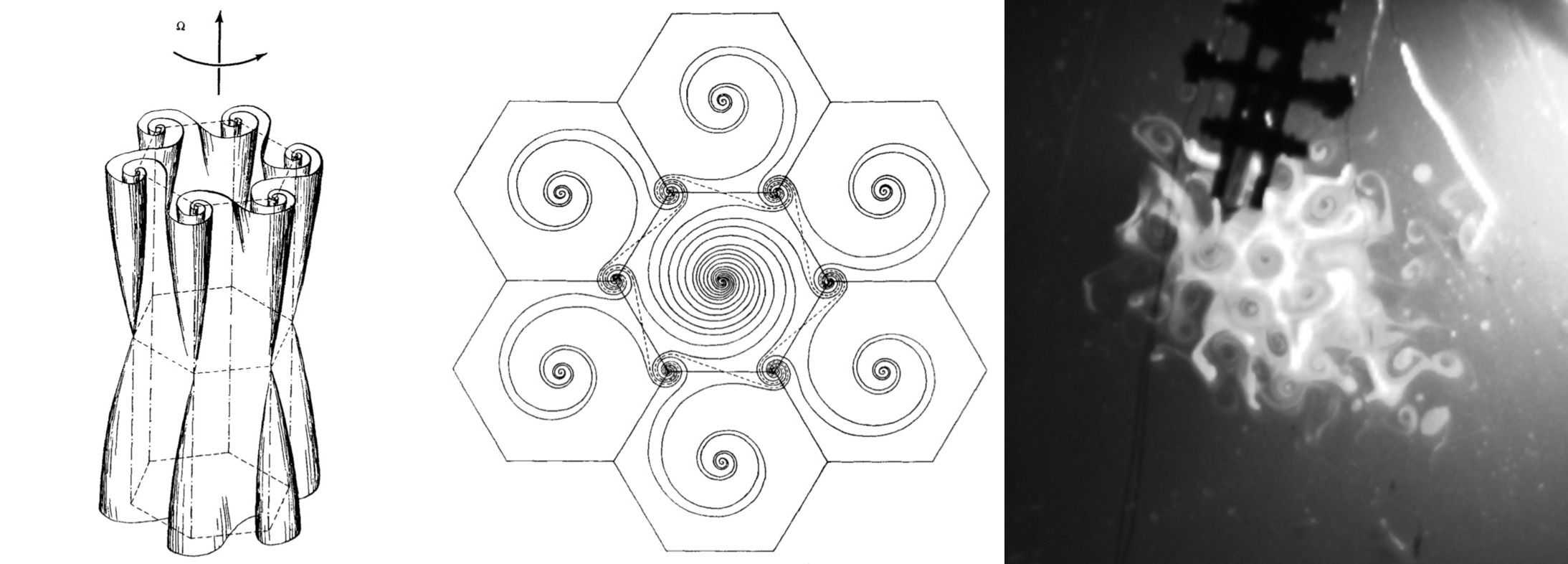My PhD Thesis
I recently purchased the most expensive book that I have ever bought, and owned it for just 15 minutes. What could such an excellent and insightful tome be?, I hear you ask. Why, my PhD thesis - ‘Laminar Analogues of Atmospheric Vortices’! Here is a brief summary of what I got up to.

In all its glory before I gave it away.
My thesis is titled ‘Laminar analogues of atmospheric vortices’. For the uninitiated, the layman’s title might be ‘Non-turbulent (smooth) models of some different types of vortex that exists in the atmosphere’. You can read it in all of its gory detail here , and it can be found on the University of Cambridge repository with the DOI: 10.17863/CAM.49925 . If you prefer the feel of a real book in your hands, however, you can get a copy from the University Library or Department of Engineering - doing this would justify the two expensive physical copies I had to get printed.
Overview
The overarching theme of the work was to examine isolated vortex structures that exist in the atmosphere by using simplified models. A vortex is a flow that rotates about some axis - for example water draining down a plughole. Though vortex flows occur across a vast range of scales in the atmosphere, from the 1000 km polar vortex down to the finescale μm motions of turbulent dissipation , my work focused on phenomena that occur at the middling scales.
Similar to the plughole vortex, the first section of my work (rotating convection) looked at understanding cylindrical vortices in the atmosphere. The study was inspired by the tropical cyclone, also known as the hurricane or typhoon, though it might also be applicable to similar structures like tornadoes and dust devils. Vortex axes don’t always have to be linear, however. An example of this is the vortex ring (think smoke ring) in which the axis of rotation is a closed loop. Such structures formed the second part of my work looking at the life cycle of laminar thermals.
Flow in the atmosphere is incredibly complex and turbulent. The main thrust of my research, and of geophysical fluid dynamics, is to construct simplified models that are still capable of replicating the behaviour of something complex. By examining how the processes occur in the simplified model as can then draw parallels (or ‘analogies’) about the more complex phenomena. My work made the simplification of removing turbulence in order to simplify the analysis of these structures.
Chapter 1 of my thesis describes in detail the different atmospheric phenomena, and presents the case for the use of simplified models.

Cylindrical atmospheric vortices - tropical cyclone, dust devil, and waterspout (Creative commons; NASA and Sinclair).
To study these phenomena I wrote some code to compute the behaviour of unsteady (changing in time) axisymmetric flow within a cylinder. The code solves the Navier-Stokes equations for laminar (non-turbulent) fluid flow using a technique based on the marker and cell method. The theory and code development are covered in chapters 2 and 3 of my thesis respectively.
Rotating Convection
The work on rotating convection details a study inspired by the
tropical cyclone
.
It builds on a
recently proposed
laminar model for the phenomena that examined how eyes might form at the centre of the vortex.
By increasing the energy of the vortex (increasing the sea temperature) we found that the the centre of the vortex may begin to oscillate or ‘wobble’.
We theorise this is a result of (
inertial
) waves trapped at the centre of the vortex.
The work is published in APS Physical Review Fluids as
Atkinson et al. (2019)
with the title Dynamics of a trapped vortex in rotating convection (
PDF
) which forms the basis for chapter 4 of my thesis.
A slightly more detailed summary of this work can be found
here
.

Numerical model of a cyclone with an eye.
In addition to this theoretical/numerical work I also performed some experimental investigations at the rotating fluids laboratory of AOPP at Oxford University . I had hoped to generate vortices with eyes to back up the new ideas about eye formation, but sadly was unsuccessful. The work does highlight a number of important points for consideration for future experimental work in this area however. This experimental work is not published, but is written up in chapter 5 of my thesis.
A nice tangential result of the experimental work were some observations of cellular convection. When a fluid is rotating and heated from below it organises into many small hexagonal cells. Though these have been been studied in theory ( Veronis , Chandrasekhar ), there are very few experimental observations of the phenomenon.
Cellular rotating convection. Comparison of experimental observations and the sketches of Veronis (1959)

Thermals
The work on thermals was inspired by the parcels of rising hot air that birds and gliders use to aid their flying. Though there has been some study of the turbulent phenomenon, the laminar equivalent is much less well studied. An early description can be found in the wonderful book On Growth and Form by the Scottish naturalist D’Arcy Wentworth Thompson. Starting with a sphere of buoyant material we observed what happened as it rose and evolved, undergoing various morphological changes to end up as a vortex ring. We separated the life cycle into three main stages: the buoyant blob, the mushroom cap, and the buoyant vortex ring.

Development of a thermal from blob, to mushroom, to vortex ring.
As well as this qualitative study we made a number of quantitative observations about the processes and phenomena with a few interesting results. These included an independence of temperature on the development of the thermal, the same quantity of heat being captured by the vortex ring each time, and the production of successive vortex rings from the wake left by the first. The other main contribution was to put forward a mathematical framework (based on impulse and vorticity flux) through which phenomena might be studied and understood.
This work was the subject of a talk that won the Best Presentation award at the 2017 UK Fluids conference, and is published in the Journal of Fluid Mechanics as Atkinson and Davidson (2019) with the title The evolution of laminar thermals ( PDF ) which forms the basis of chapter 6 of my thesis. A slightly more detailed summary can be found here .
In addition to this theoretical/computational study I also performed some laboratory experiments on laminar thermals which let to some nice images and movies. One of these movies comparing the real and numerical experiments was shortlisted in the 2019 CUED photo competition .

Experiments of thermals
Acknowledgements
Useful references have provided as hyperlinks throughout the text. For a more complete list of sources and further reading please see the bibliography of my thesis.
The bulk of my work was funded through a doctoral training award from the University of Cambridge Department of Engineering paid for by EPSRC .
My experimental work in Oxford was funded by a Short Research Visit grant from the UK Fluids Network . Some of the apparatus was funded by the Max Perutz award from Peterhouse .
I also received a research studentship from the Cambridge Philosophical Society that allowed me to complete my work and publish the two articles above.
Finally I wish to acknowledge my supervisor, Professor Peter Davidson, my colleagues, those I have been fortunate to have a friends over the course of my studies, and, most of all, my family.